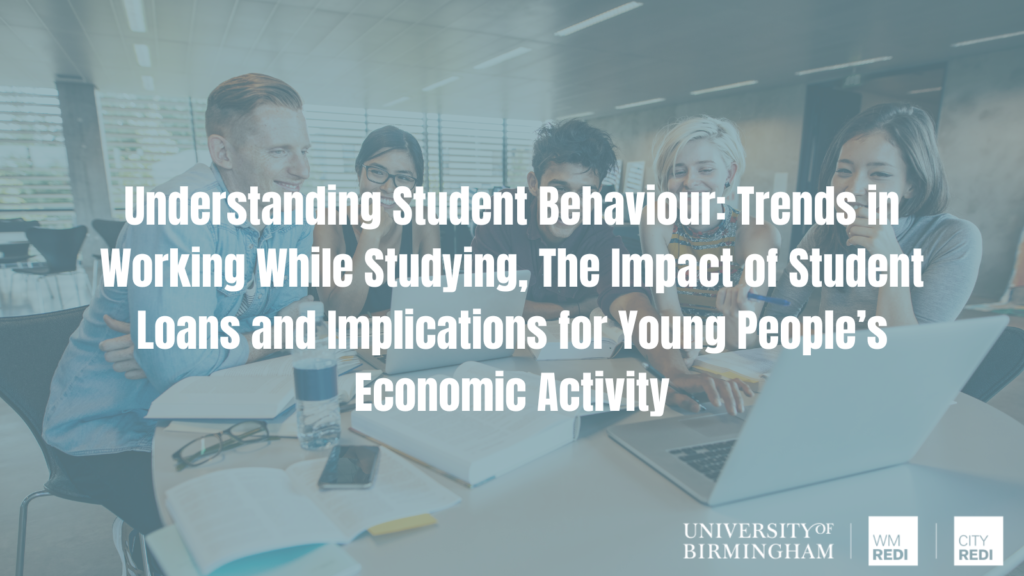
Dr Kostas Kollydas discusses changes over time in student employment, student loan developments, and the likely effects of these changes on the educational and economic outcomes of young individuals. This blog is part of a series looking at the UK Labour Market. See also: - Why are the Over-50s Leaving the Workforce? Labour Market Flows and Future Participation Flows - What Are the Current Challenges in the UK Labour Market and How Can They Be Addressed? - How do Fertility Rates and Childcare Costs Play out in the UK Labour Market? - International Migration and the UK Labour Market: Changes and Challenges
Temporal trends in working while studying
Over the past thirty years, the number of students who work while studying in the UK has risen. According to an OECD report, almost half of young people aged 16-29 in England and Northern Ireland combined work and study in 2012, a higher proportion than the average of 39% across 23 countries that participated in the Survey of Adult Skills. The abovementioned report suggests that working while studying is more common in Anglo-Saxon countries and those with an established apprenticeship tradition, but less so in countries/regions like Italy, Czech Republic, Flanders (Belgium), Slovakia, and France.
While over a quarter of full-time higher education students were estimated to be working during term-time in the early 1990s, evidence from the National Union of Students (NUS) and the Trades Union Congress suggests that the number of full-time students in employment increased significantly (by approximately 55%) between 1996 and 2006. The Student Income and Expenditure Survey (SIES) revealed that 52% of full-time students engaged in some form of paid work during term-time in the academic year 2014/15. On average, these students earned approximately £3,300 from paid employment. Relatedly, a survey conducted by the NUS and Endsleigh Insurance in 2015 found that 77% of university students worked to support their studies, while a non-negligible percentage (13%) were estimated to work full-time in 2014.
The growing prevalence of higher education students in employment can be attributed to a number of factors. First, the expansion of the higher education sector has led to a larger and more diverse student population, including those from disadvantaged backgrounds, such as lower socio-economic or ethnic minority groups, who may need to work to partly fund their studies. Second, the reforms to tuition fee policies have transferred the burden of costs from the state to students, as part of an effort to ensure the long-term sustainability of funding for higher education. Tuition fees were introduced in 1998 (£1,000), with subsequent increases in 2006 (a fee cap of £3,000 for UK and EU students), 2012 (£9,000), and 2017 (£9,250), with students being able to obtain loans to pay for their tuition fees and living expenses. In addition, the cost of living has recently risen significantly, resulting in financial difficulties for 50% of students. This has negatively impacted students’ academic performance and plans to continue their studies after completing their course. Due to the rising cost of living, 27% of university students have sought employment or increased their working hours during the current academic year (2022/23), as shown by a recent survey conducted by the Sutton Trust.

Motives for working while studying and variations in students’ engagement in paid work
Students have various reasons for working while studying, including a desire to pay for leisure activities and meet financial needs, reduce debt, and acquire general or career-related experience. These reasons may differ depending on their socio-economic background and area of study. For example, those who work to fund their studies often come from lower social classes and receive limited financial support from their families. Additionally, science students, such as those studying medicine or biosciences, typically spend more time in labs, which can make it harder for them to work during the academic term.
In the 2014/15 academic year, paid work accounted for 73% of the total income of part-time students and 10% of the total income of full-time students. This made it the third largest source of income for full-time students, after tuition fees/maintenance loans and other forms of student support provided by universities, the NHS or employers. According to the Student Income and Expenditure Survey (SIES), students from higher socio-economic groups (i.e. managerial or professional work backgrounds) tended to rely less on paid work for their income than those from intermediate and routine/manual work backgrounds. In addition, women, independent students, those pursuing education-pertinent degrees, and students residing with their parents were more likely to work during their studies.
Impact of working while studying on academic and labour market outcomes
According to the human capital theory, work experience is associated with the development of various skills, which may include both technical and transversal skills (such as social, communication and management skills). Therefore, working while studying (particularly if work relates to the field of study) can provide students with valuable work experience and help them to acquire skills that will be useful in their future careers. This can also lead to positive behavioural attitudes, higher self-efficacy, an increase in the perception that they can control their life events (a concept known as “internal locus of control”) and, in some cases, higher salaries and employability after graduation.
On the other hand, term-time employment can negatively impact students’ academic achievement and increase the likelihood of dropping out, which are both strong correlates of labour market outcomes. Similarly, working students may miss more lectures, have fewer opportunities to attend social or club activities, which are important for their personal and social development, and could experience higher stress levels.
Working students frequently have limited control over the type and amount of paid work they engage in. Therefore, it is crucial that higher education institutions provide students with additional support (especially those from financially constrained backgrounds) and employment opportunities that balance their academic and work commitments effectively (through targeted placement programmes or flexible working arrangements, for example) and do not hamper their academic performance and their overall benefits and experiences from studying at university.

Impact of student loans on educational choices and economic activity
Some students exhibit a greater reluctance to incur debt (“debt aversion”) when they perceive the financial and psychological costs of receiving a loan as outweighing the potential benefits of investing in higher education (e.g., improved employment and earnings prospects later in life). This behaviour is likely influenced by sociological and cultural determinants, beliefs, or previous negative experiences with loans by their families. It appears that the educational choices of women, ethnic minorities, older students, those from lower socio-economic backgrounds, and those with health issues or disabilities are more likely to be adversely affected by the cost of higher education. Nonetheless, surveys indicate that student attitudes toward loans have improved over time, with an increasing proportion of students viewing borrowing as a wise investment. In particular, 74% of prospective undergraduates in 2015 agreed with the statement that “borrowing money to pay for a university education is a good investment”, up from 52% in 2002, with women accounting for a significant proportion of the increase.
The impact of student loans on young people’s economic activity is complex. While loans provide financial support for students to pursue their studies and invest in their future, the burden of loan debt might have long-term implications for their financial stability and their capacity to participate in the broader economy, including the housing market. For instance, there is evidence that homeownership is more common among graduates who did not borrow for higher education, with more graduate non-borrowers owning their home than graduate borrowers (a difference of 13.1 percentage points), even when demographic and socioeconomic characteristics, as well as differences in local housing markets, are taken into account. Moreover, the psychological impact of debt may dissuade some students from obtaining further loans.

Graduates, on average, accumulate around £45,000 in debt, but most are unlikely to repay their loans in full, with the total amount of unpaid debt predicted to reach around £560 billion by 2050. Recent reforms to the student loan system, including changes to repayment thresholds and interest rates, are anticipated to have a negative impact on graduates with lower-middling earnings, although they will likely deliver savings to taxpayers.
Finally, approximately 1.1 million undergraduates from England were given a maintenance loan for living expenses in the academic year 2021/22. However, the proposed 2.8% increase in the student support package for living costs in 2023/24 is insufficient to keep up with the rising inflation and cost of living. Consequently, this will likely have a negative impact on students’ spending power, particularly those from lower socio-economic backgrounds.
This blog was written by Dr Kostas Kollydas, Research Fellow at City-REDI / WMREDI, University of Birmingham.
Disclaimer:
The views expressed in this analysis post are those of the authors and not necessarily those of City-REDI / WMREDI or the University of Birmingham.
